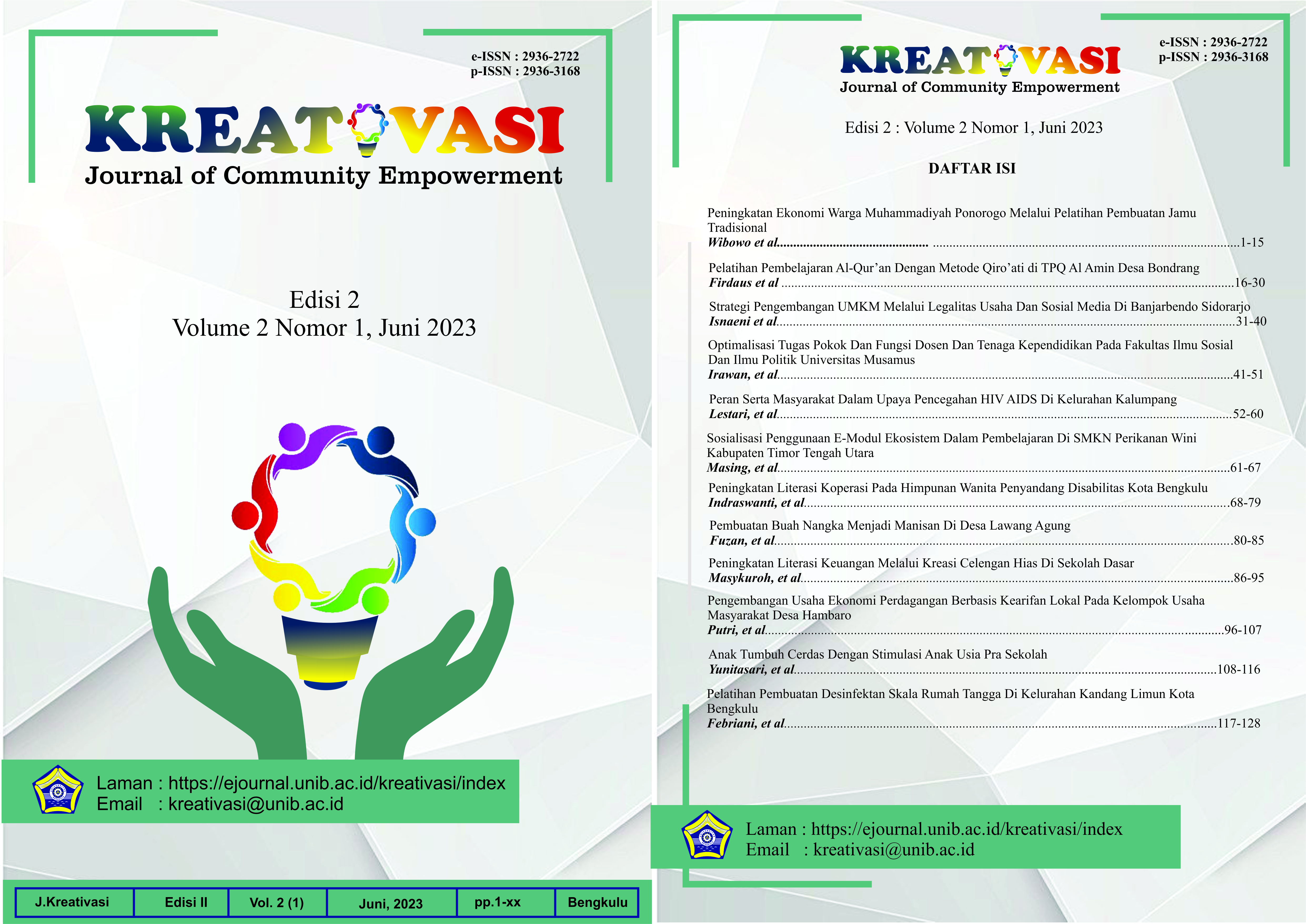Main Article Content
Abstract
Tuna is a marine product that is mostly produced by fishermen in the city of Bengkulu at a relatively affordable price. The training activities for making shredded tuna business generally aim as a source of fulfilling nutrition, the nutrients contained in tuna fish are able to meet the nutritional needs of families in the disabled group. In addition to fulfilling family nutrition, the processing of shredded tuna produced will be able to become a source of income for people with disabilities. This community service activity is carried out using counseling methods and training in making shredded tuna. From the activities carried out it can be seen that the participants were enthusiastic to take part in the activities both in the delivery of material and practice from people with disabilities in Bengkulu City.
Keywords
Article Details
Copyright (c) 2023 Barika Barika, Eka Dewi Anggraini, Izharudin

This work is licensed under a Creative Commons Attribution-ShareAlike 4.0 International License.
- This statement is a commitment from the author, to respect copyright, both in terms of quoting the work of others, as well as in the use of journal content.
- If needed, the author can send a statement of authenticity of the manuscript. With the receipt of an article by the Editor of Kreativasi - Journal of Community Empowerment, the article submitted has the copyright held by Kreativasi - Journal of Community Empowerment:
- Kreativasi - Journal of Community Empowerment has the right to reproduce and distribute articles that have been published in journals.
- The author is not permitted to publish the same article that has been published in this journal.
References
- Albrecht, G.L., Seelman, K.D., & Bury, M. (2001). Handbook of disability studies. SAGE Publication, Inc.
- Darcy, S., Taylor, T., & Green, J. (2016). “But I can do the job”: examining disability employment practice through human rights complaint cases. Disability & Society, 31(9), 1242–1274. doi:10.1080/09687599.2016. 1256807
- Deuchert, E., Kauer, L., Liebert, H., & Wuppermann, C. (2017). Disability discrimination in higher education: analyzing the quality of counseling services. Education Economics, 25(6), 543–553. doi:10.1080/ 09645292.2017.1325838
- Devlieger, P., Rusch. F., & Pfeiffer. D. (2003). Rethinking disability: The emergence of new definition, concepts and communities. Philadelphia. PA: Garant Press
- Ferguson, P. M., & Nusbaum, E. (2012). Disability Studies: What is it and what Difference does it Make? Research and Practice for Persons with Severe Disabilities, 37(2), 70–80. doi:10.1177/154079691203700202
- Friedrich, M. J. (2017). Depression Is the Leading Cause of Disability Around the World. JAMA, 317(15), 1517. doi:10.1001/jama.2017.3826
- Goodley, D. (2017). Disability Studies: An Interdisciplinary Introduction, second edition. SAGE Publication, Ltd.
- Himpunan Wanita Penyandang Disabilitas Kota Bengkulu. (2022). Data asessment. https://mediaindonesia.com/nusantara/223041/produksi-ikan-tuna-bengkulu-naik https://simpd.kemensos.go.id/
- Krahn, G.L. (2011). WHO World Report on Disability: A review. Disability and health journal, vol. 4, p. 141-142.
- Pawestri, A. (2017). Hak penyandang disabilitas dalam prespektif HAM internasional dan HAM nasional. Jurnal Ilmu Hukum, Vo. 2, no. 1. p. 164-182
- Temple, J.B. , Kelaher, M., & Williams, R. (2018). Discrimination and avoidance due to disability in Australia: evidence from a National Cross Sectional Survey. BMC Public Health, 18:1347 https://doi.org/ 10.1186/s12889-018-6234-7
- Thomson, R.G. (2017). Chapter Title: Building a World with Disability in It. Book Title: Culture – Theory – Disability. Transcript Verlag. JSTOR.
- Widinarsih, D. (2019). Penyandang disabilitas di Indonesia : Perkembangan istilah dan definisi. Jurnal Ilmu Kesejahteraan Sosial, jilid 20, nomor 2. p. 127-142.
References
Albrecht, G.L., Seelman, K.D., & Bury, M. (2001). Handbook of disability studies. SAGE Publication, Inc.
Darcy, S., Taylor, T., & Green, J. (2016). “But I can do the job”: examining disability employment practice through human rights complaint cases. Disability & Society, 31(9), 1242–1274. doi:10.1080/09687599.2016. 1256807
Deuchert, E., Kauer, L., Liebert, H., & Wuppermann, C. (2017). Disability discrimination in higher education: analyzing the quality of counseling services. Education Economics, 25(6), 543–553. doi:10.1080/ 09645292.2017.1325838
Devlieger, P., Rusch. F., & Pfeiffer. D. (2003). Rethinking disability: The emergence of new definition, concepts and communities. Philadelphia. PA: Garant Press
Ferguson, P. M., & Nusbaum, E. (2012). Disability Studies: What is it and what Difference does it Make? Research and Practice for Persons with Severe Disabilities, 37(2), 70–80. doi:10.1177/154079691203700202
Friedrich, M. J. (2017). Depression Is the Leading Cause of Disability Around the World. JAMA, 317(15), 1517. doi:10.1001/jama.2017.3826
Goodley, D. (2017). Disability Studies: An Interdisciplinary Introduction, second edition. SAGE Publication, Ltd.
Himpunan Wanita Penyandang Disabilitas Kota Bengkulu. (2022). Data asessment. https://mediaindonesia.com/nusantara/223041/produksi-ikan-tuna-bengkulu-naik https://simpd.kemensos.go.id/
Krahn, G.L. (2011). WHO World Report on Disability: A review. Disability and health journal, vol. 4, p. 141-142.
Pawestri, A. (2017). Hak penyandang disabilitas dalam prespektif HAM internasional dan HAM nasional. Jurnal Ilmu Hukum, Vo. 2, no. 1. p. 164-182
Temple, J.B. , Kelaher, M., & Williams, R. (2018). Discrimination and avoidance due to disability in Australia: evidence from a National Cross Sectional Survey. BMC Public Health, 18:1347 https://doi.org/ 10.1186/s12889-018-6234-7
Thomson, R.G. (2017). Chapter Title: Building a World with Disability in It. Book Title: Culture – Theory – Disability. Transcript Verlag. JSTOR.
Widinarsih, D. (2019). Penyandang disabilitas di Indonesia : Perkembangan istilah dan definisi. Jurnal Ilmu Kesejahteraan Sosial, jilid 20, nomor 2. p. 127-142.
